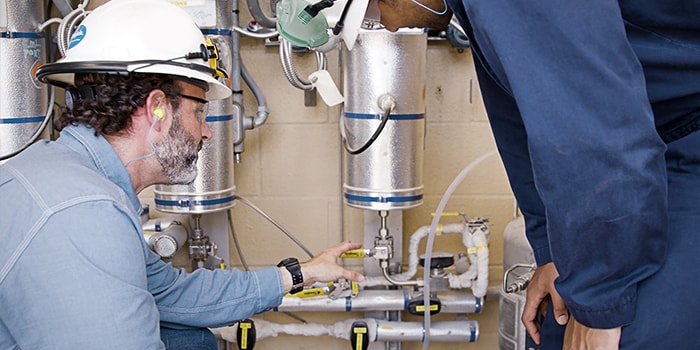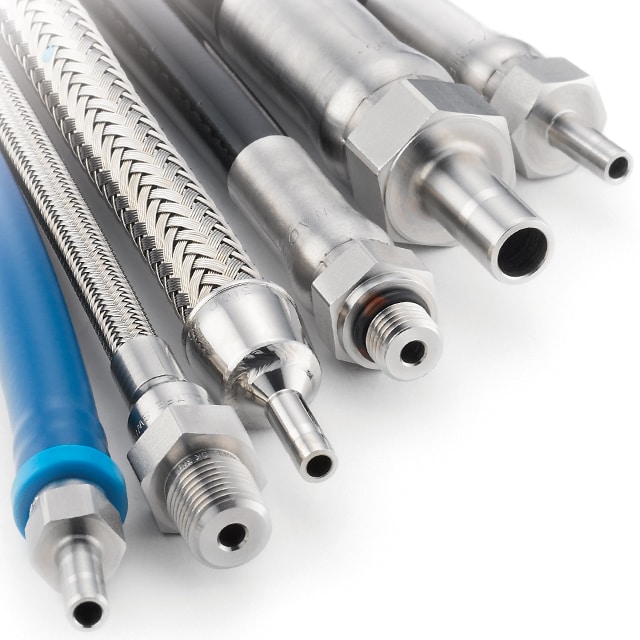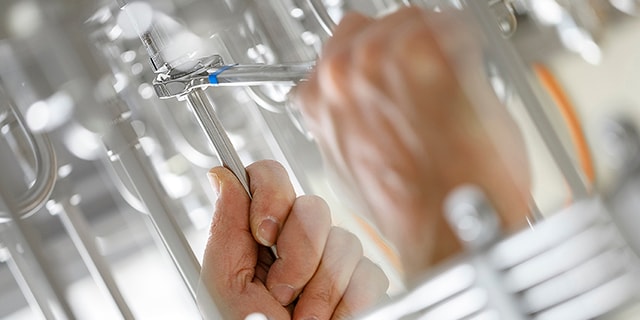How to Improve Fluid System Performance

How to Improve Fluid System Performance
Cory Cottrill, Product Manager, Field Services
In busy plants and factories, fluid system performance can sometimes take a back seat to other priorities. However, without proper care, problems can develop quickly. The key to protecting operations and maintaining fluid system safety and performance is to create a learning culture that focuses on continuous system improvement, minimizing installation errors, and equipping employees with the skills to tackle jobs with confidence.
Every year, Swagelok field service engineers visit thousands of industrial facilities to advise customers on fluid system maintenance. Inefficiencies resulting from unresolved fluid system issues can be costly and, worse, put people at risk when fugitive emissions become major hazards. Consider these steps to ensuring optimized fluid system performance.
Invest in Fluid System Training and Education
Most fluid system problems are related to installation issues, not individual component failures. It is not uncommon to spot fittings that are not properly tightened or ferrules that have been turned backward. Both these conditions can invite leaks and fugitive emissions. Even professionals with decades of experience can make these common errors if they were not properly instructed on optimized performance and fluid system leak detection.
A fluid system training program focused on material selection, assembly/installation, and routine maintenance considerations can help prevent poor system health by teaching employees how to work safer and smarter. Education also familiarizes employees with correct terminology, better equipping them to have a conversation if something goes wrong. Without the right vocabulary or understanding, technicians might be reluctant to talk about technical issues. Other times, a recommendation can be lost in translation, resulting in wasted time and resources. Improving communication and understanding of common terminology can improve fluid system troubleshooting and fluid system leak detection.
Training programs also introduce employees to expert resources they can turn to when questions arise. Sometimes it simply takes asking a vendor who has seen the problem before to relieve the day-to-day pressures placed on engineers, technicians, installers, and other plant employees.
Diagnosing Fluid System Concerns
Many times, a leaky valve or noisy regulator is replaced with the same component. Standard corrective measures can solve some problems, but they may not address the root cause of other issues. These can include excess pressure in the system, excessive vibration, incompatible materials and componentry, and other challenges.
It is simple to swap out a part, but without knowing the reasons why it failed, the problem may recur. A training program aimed at identifying the issue, creating a repairs roadmap, and pushing the process to completion can help by teaching employees how to trace problems back to the source.
It is always advisable to seek expert help when diagnosing fluid system concerns and preventing fugitive emissions. No two systems are perfectly identical, and an approach that was effective in the past may not produce the same result in a different application. Seeing past the symptoms to identify the source of the issue requires a thorough understanding of how components and systems work together. While it might be easy to find answers online, only an on-site audit can determine in detail the condition of a fluid system. Taking advantage of system evaluation and advisory services can be valuable.
Make It Easy to Make Fluid System Improvements
Changes to fluid systems often require departmental approvals. For instance, it may be appropriate to switch from a gate valve to a ball valve in a certain application, but if the authorization process is difficult, it will only delay solving the problem. Other times, maintenance staff may view a specific issue as engineering’s responsibility, or vice versa, leading to a stalemate and increased spending when systems start to fail.
One strategy is to grant a review panel the power to fast-track improvements and repairs that all departments agree are a good idea, while setting monthly goals to keep teams accountable to the work. Simply bringing decision-makers together can spur dialogue and lead to fast action. At the same time, each department can share concerns based on its unique perspective, helping to uncover problems that are only obvious when looking at the complete system.
Consider enlisting the help of a trusted expert who can work with individuals responsible for different functions of the plant. This can foster collaboration between departments, and, in many cases, a third party can be the driving force that gets projects off the ground and maintains the momentum until a successful outcome is achieved.
Reward Those Who Go the Extra Mile
When employees feel good about making repairs, fluid system maintenance can become a priority. Incentive programs can add an element of fun and competitiveness, translating to a proactive approach to system upkeep over months and years. The reality is that repair work can be tedious, but when it comes with a sense of pride and accomplishment, there can be enthusiasm for tackling even the most routine tasks.
Incentivized maintenance can go a long way toward improving operational efficiency. Statistics show that many plant-related safety incidents are preventable, and simple troubleshooting and sound design practices can save customers tens of thousands of dollars or more in lost time, material waste, cleanup costs, and other expenses that come with correcting a problem only after a failure has occurred. Regular maintenance can be made more engaging for employees who also develop a deeper appreciation for how they can personally impact plant productivity and fluid system safety, day in and day out.
Additional Considerations
There are many other ways to safeguard fluid systems and prevent fugitive emissions by knowing what to look for and what not to do:
- Watch and listen for warning signs. While industrial process systems tend to hiss, bang, clang, and thump, such sounds typically spell trouble for fluid system components. A third party can offer a fresh set of eyes and ears for picking out problems employees are used to seeing and hearing.
- Only trust a specialist. Do not chance critical operations to anyone who is not well-versed in system health and performance. Fluid system specialists can help identify many issues others may have missed.
Get Started Today
A new routine can re-energize facilities where fluid systems are starting to fall out of shape. Even one employee with the know-how and incentive to make improvements can be a powerful force inside a plant. By creating a culture that emphasizes optimal system health, costly repairs and accidents can be avoided. A Swagelok expert can help tailor a strategy that meets the specific needs of any site.
Related Articles

Maximizing the Life of Industrial Fluid System Components
The cost of replacing an industrial fluid system component goes beyond the price of the part. Learn how to lower system costs while maximizing the life of your components with preventive maintenance tips from the professionals at Swagelok.

7 Tips for Building Safer Industrial Fluid Systems
When designing industrial fluid systems, plant safety must always remain top of mind. Learn how your team of engineers and technicians can reduce safety risks and maintain system uptime with essential fluid system building and design tips.

Common Causes and Costs of Fluid System Leaks
The smallest leak can present a serious issue when maintaining your plant’s safety and profitability. Understand how and why leaks occur, how to locate and test for them, and ultimately how to develop a strategy to address and reduce leaks plant-wide.

